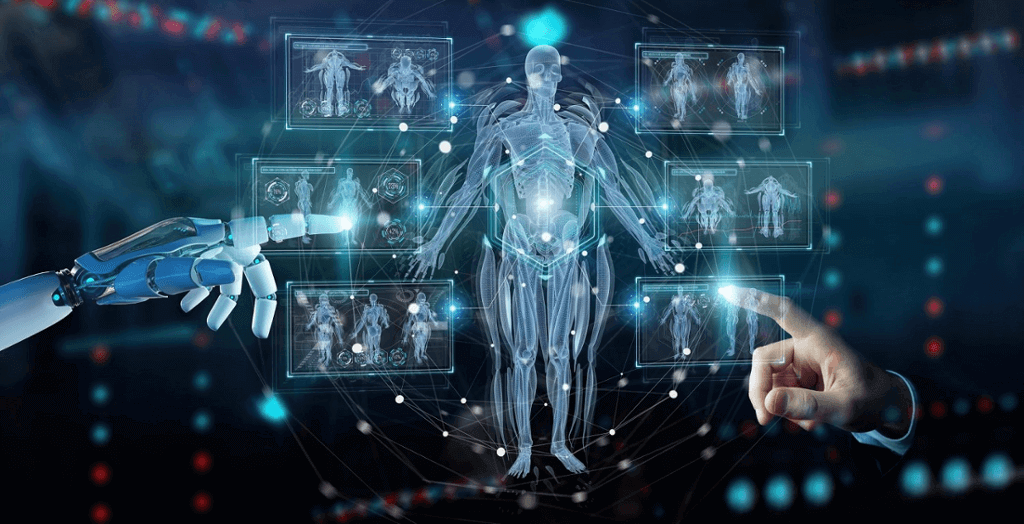The rise of artificial intelligence (AI) has been nothing short of astronomical. Predictions indicate that by 2028, the global AI market is poised to reach $914.8 billion, which signifies a game-changing shift in how technology shapes our world.
One sector experiencing profound transformation through AI is healthcare, especially medical imaging. AI, leveraging deep learning algorithms, is augmenting our ability to analyze medical scans with precision, speed, and consistency, surpassing human capability.
This article delves into the significant strides made in artificial intelligence in medical imaging. We’ll offer insights into the revolution underway in healthcare diagnostics.
How Can Artificial Intelligence Change Medical Imaging?
Artificial intelligence (AI), particularly machine learning (ML) technologies, are poised to revolutionize medical imaging. They have the potential to significantly advance medical screenings, improve precision medicine, and aid in understanding and assessing risk.
- Advancing Medical Screenings
Traditional medical imaging relies on X-rays, MRIs, and CT scans. Radiologists closely study these images to identify irregularities. But, their accuracy can be affected by error, workload, and fatigue, which is where medical AI can help. It’s effective in image analysis, segmentation, and recognition.
Machine learning (ML) algorithms that are trained on large datasets can spot patterns and anomalies that humans might miss. They increase efficiency and diagnostic accuracy.
AI has shown great success in radiology. Especially in chest X-rays, AI algorithms precisely identify diseases like tuberculosis, pneumonia, and lung cancer. They often surpass experienced radiologists. Their use can lead to early detection and quick treatment, improving patient outcomes significantly.
- Improving Precision Medicine
Precision medicine—an approach for disease treatment and prevention considering individual variability in genes, environment, and lifestyle—is another area where AI and medical imaging converge, leading to significant improvements.
A key application of AI in precision medicine lies in the field of oncology. Using AI for image analysis, doctors can identify tumor characteristics with heightened precision to guide personalized treatment plans.
AI’s ability to process and analyze vast amounts of imaging data swiftly allows for fine-grained image segmentation. This process enables a detailed understanding of tumor morphology, cell density, and other attributes crucial to develop a tailored treatment plan.
AI in image analysis can also facilitate real-time monitoring of the patient’s response to the treatment. It offers possibilities for timely course correction.
- Indicating and Assessing Risk
AI also plays a pivotal role in risk assessment and indication, offering predictive insights to enhance patient care. For instance, AI algorithms can analyze patient records and medical images to predict the risk of future health issues, even before symptoms manifest.
Machine learning models, trained on vast datasets, can predict the progression of diseases such as Alzheimer’s, Parkinson’s, and multiple sclerosis by analyzing MRI scans. Moreover, AI can scrutinize CT scans and X-rays. They can identify markers indicative of chronic conditions like heart disease and osteoporosis, often before patients become symptomatic.
Further, AI can evaluate the risk factors contributing to the disease, such as age, genetic predisposition, lifestyle habits, and co-morbidities. This comprehensive risk assessment can pave the way for preventive strategies and timely interventions to enhance the overall effectiveness of medical care.
Open-access medical image datasets have been instrumental in the rapid advancement of AI in healthcare. These collections of anonymized patient images, ranging from X-rays and CT scans to MRIs, provide information for training AI algorithms.
Open-Access Medical Image Datasets
One such resource is the Cancer Imaging Archive, a massive collection of cancer-specific medical images for public use. It aids in training machine learning models to identify and segment cancerous cells accurately.
The National Institutes of Health (NIH) also offers a dataset known as ChestXray14. This dataset includes over 100,000 anonymized chest X-ray images. It’s a crucial tool for developing AI systems that detect lung diseases like pneumonia or tuberculosis.
Then, there’s the Retinal OCT Images dataset, essential for training AI in diagnosing and monitoring diseases affecting the retina. It’s particularly beneficial for spotting conditions like macular degeneration, which could lead to vision loss if not treated promptly.
Open-access datasets are not confined to specific medical fields or disease types. The MIMIC-III (Medical Information Mart for Intensive Care) dataset is a vast, diverse collection. It consists of de-identified health data associated with over forty thousand patients who stayed in critical care units.
The medical community offers these open-access datasets to foster innovation in AI applications for healthcare. This valuable data enables researchers and developers to train and validate their AI models.
Thus, these models can potentially improve diagnoses, prognosis predictions, and the overall delivery of patient care. As AI continues to evolve, the importance of such datasets in shaping the future of healthcare is hard to overstate.
Also read:- write for us tech
Also read:- Technology write for us
Also read:- write for us technology blogs
What Shaip Can Do For You
Shaip stands at the forefront of providing top-notch healthcare and medical data vital for AI and machine learning (ML) models. If you are embarking on a healthcare AI project or require specific medical data, Shaip is the perfect partner.
What makes Shaip a unique data partner?
- Range of Datasets: Shaip offers a broad spectrum of datasets, including de-identified physician dictation audio data, transcribed medical records, electronic health records (EHR), and medical imaging data such as CT scans, MRIs, and X-rays. These datasets span 31 different medical specialties to ensure comprehensive coverage for your project’s needs.
- Physician Dictation Data: Shaip’s unique offering of over 257,977 hours of real-world physician dictation provides an invaluable resource for training healthcare speech models. The data captured from various devices is de-identified, adhering to Safe Harbor Guidelines in line with HIPAA. Thus, they ensure patient data privacy and security.
- Transcribed Medical Records: Shaip provides a detailed written record of patient care in the form of transcribed medical records. This comprehensive dataset includes diverse work types such as operative reports, consultation notes, discharge summaries, and more, which are instrumental in mapping a patient’s medical history.
- Electronic Health Records (EHR): Shaip excels in EHR, offering more than 5.1 million records that can serve as a gold standard for training clinical Natural Language Processing (NLP) and other Document AI models.
- Medical Image Datasets: Shaip provides high-resolution, quality image datasets such as CT scans, MRIs, and X-ray images. This data is fundamental in advancing computer vision models, contributing to better diagnosis and treatment prediction.
Shaip is your one-stop solution for all your healthcare data needs. Their offerings aid in building robust, effective, and accurate AI models for healthcare. It helps accelerate your AI projects and ensure superior outcomes.
Author bio:
Hello, I am a professional SEO Expert & Write for us Technology blog and submit a guest posts on different platforms- we provides a good opportunity for content writers to submit guest posts on our website. We frequently highlight and tend to showcase guests.




